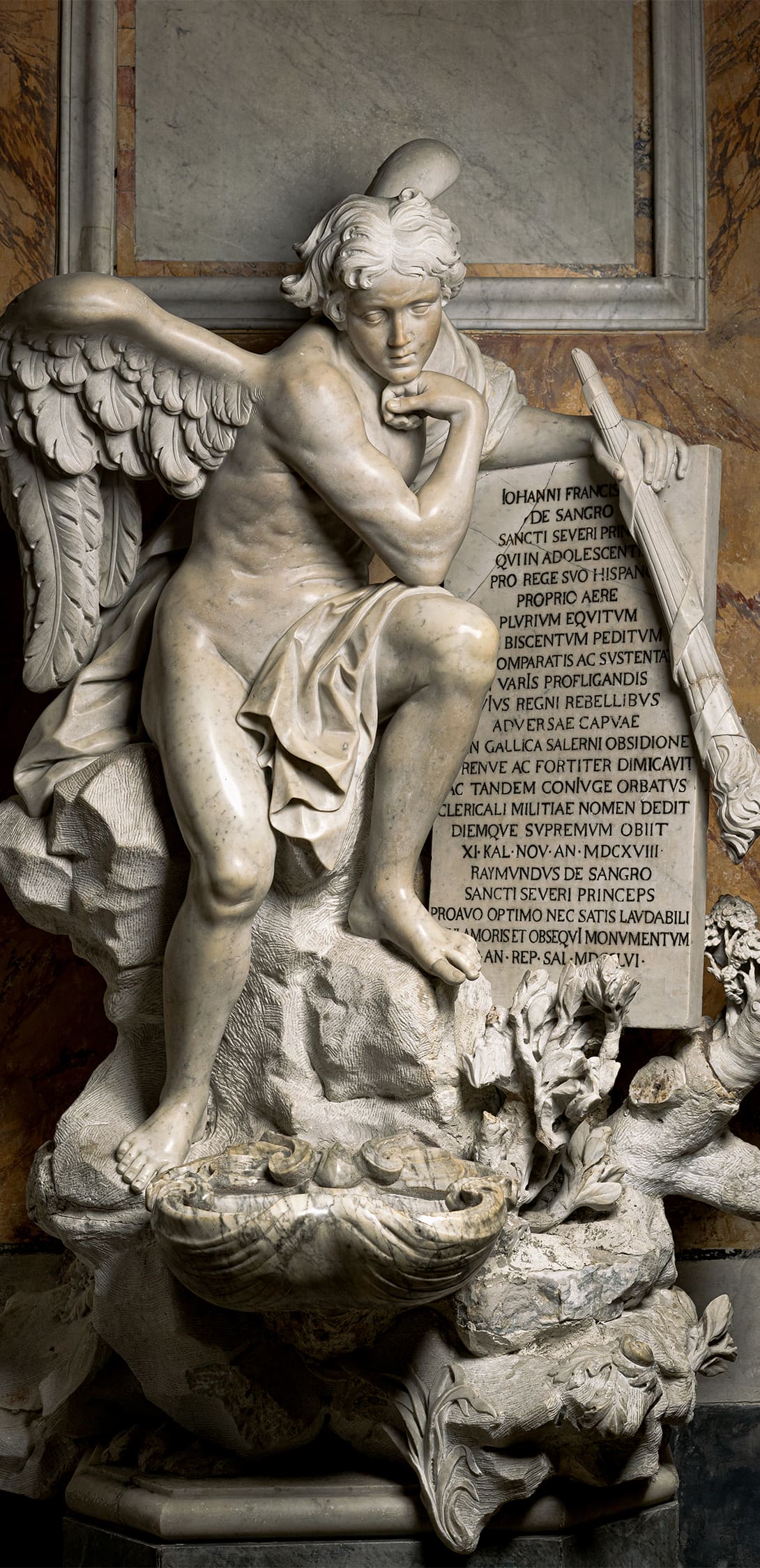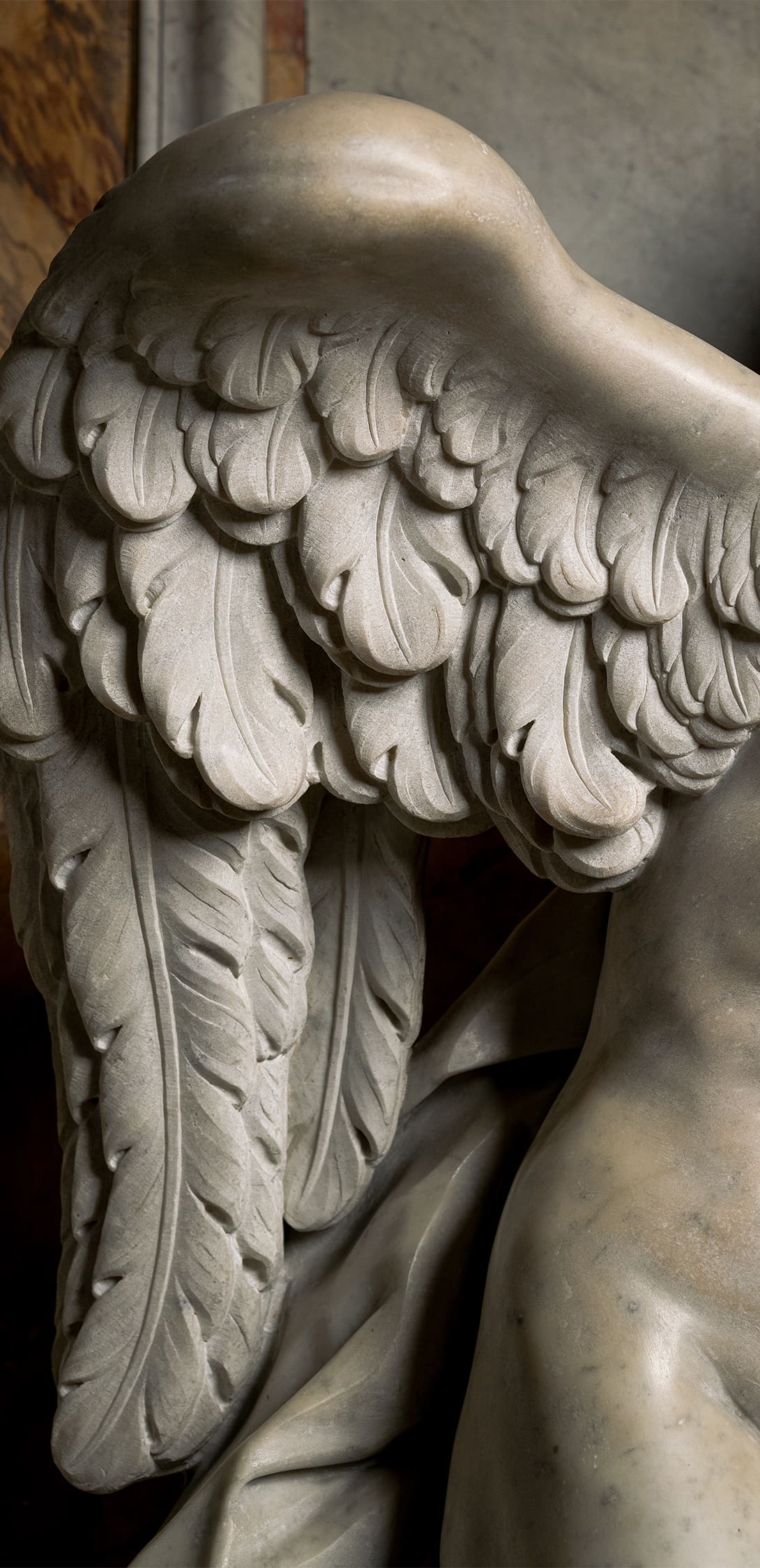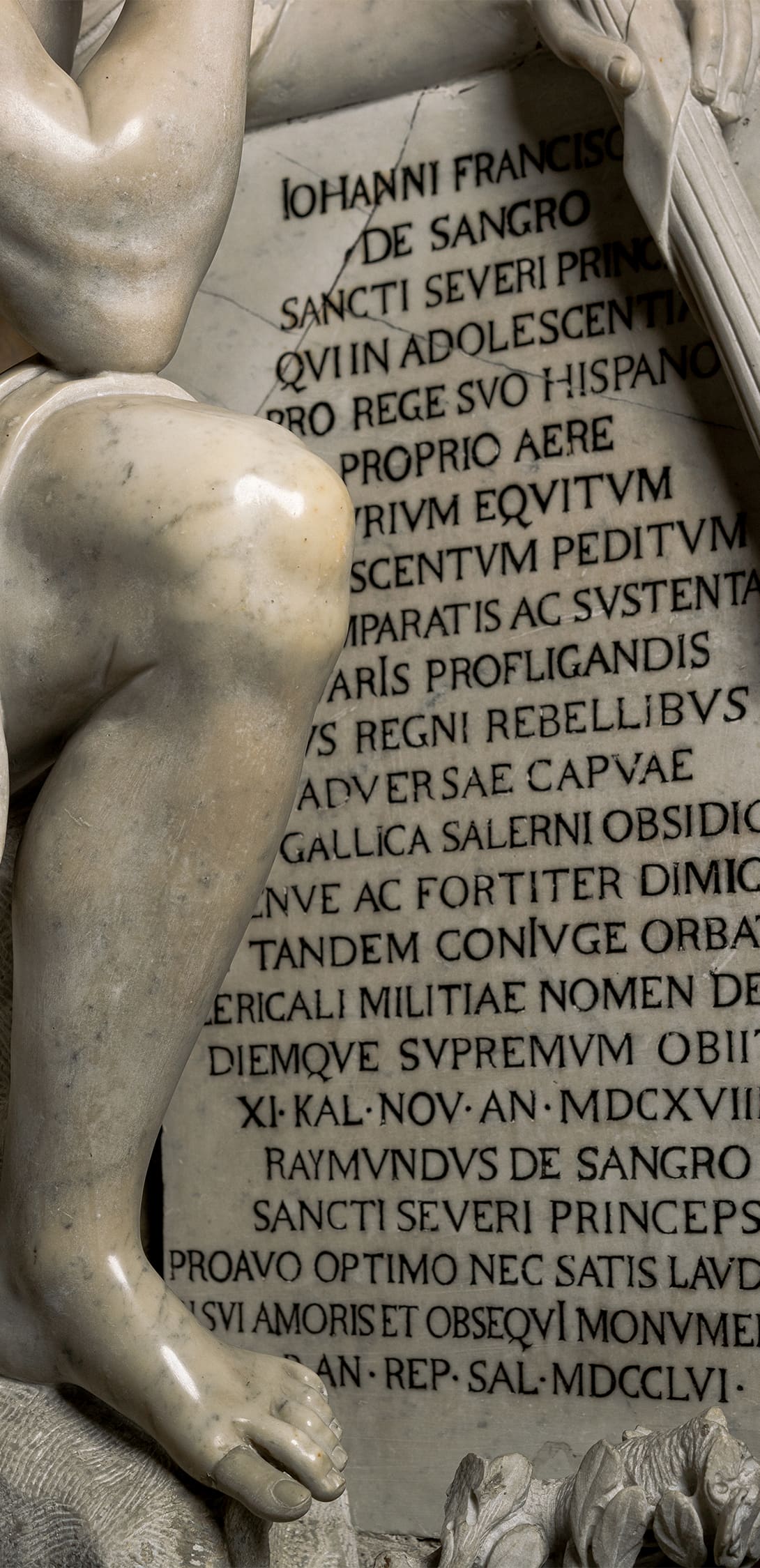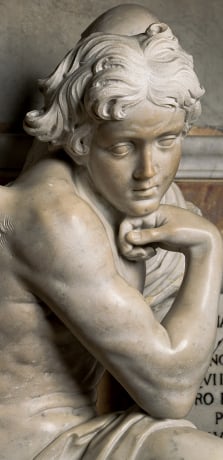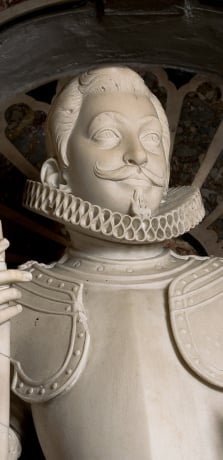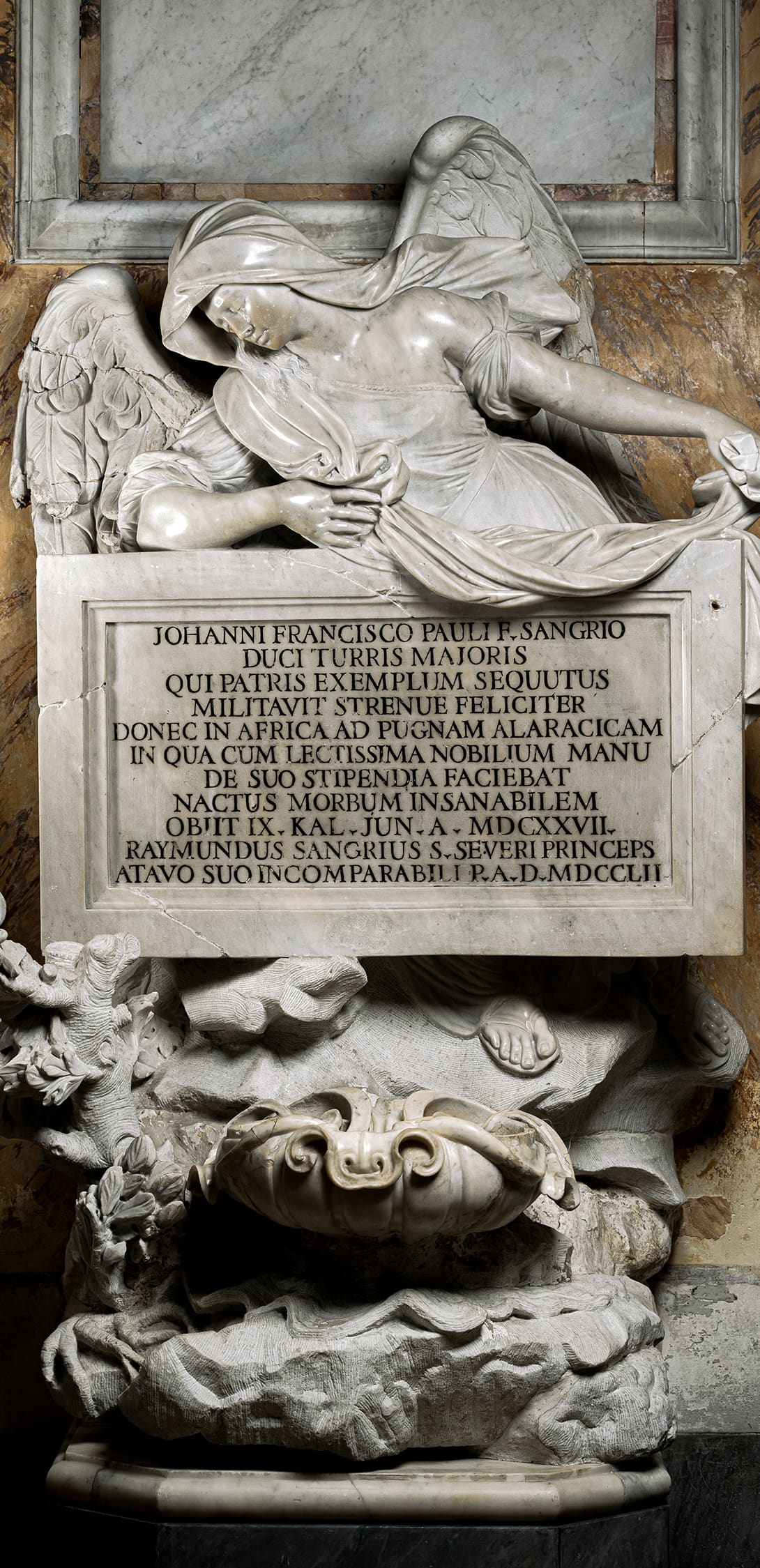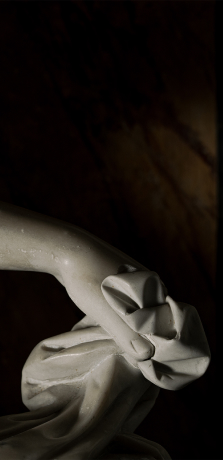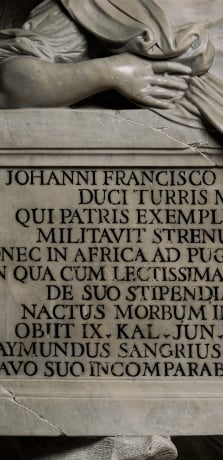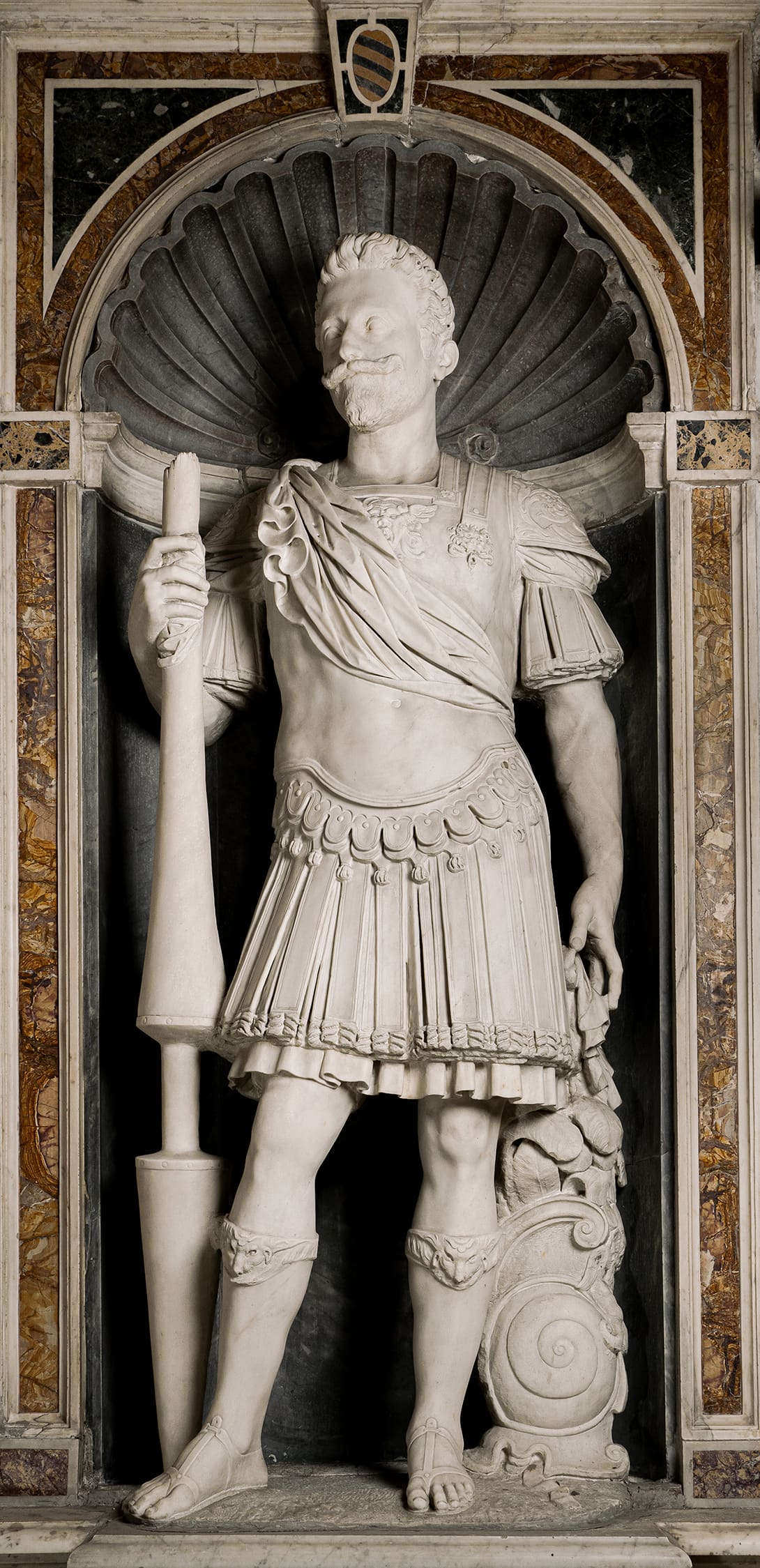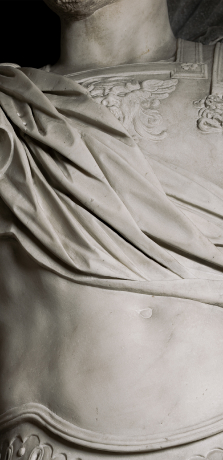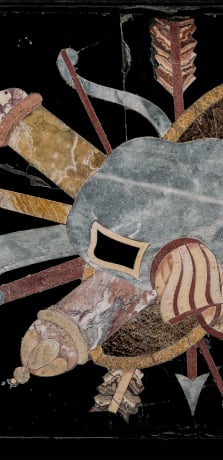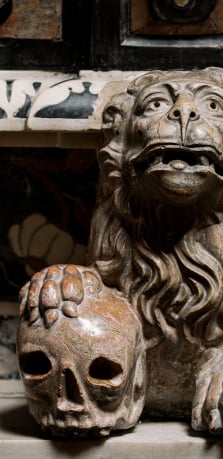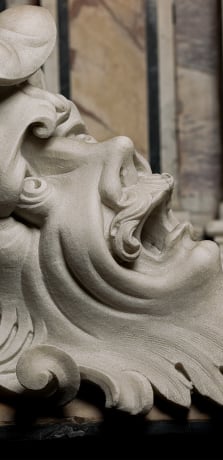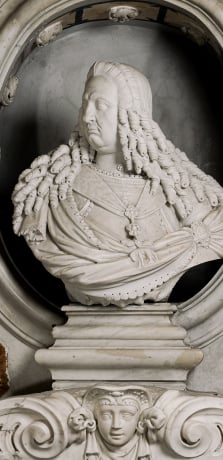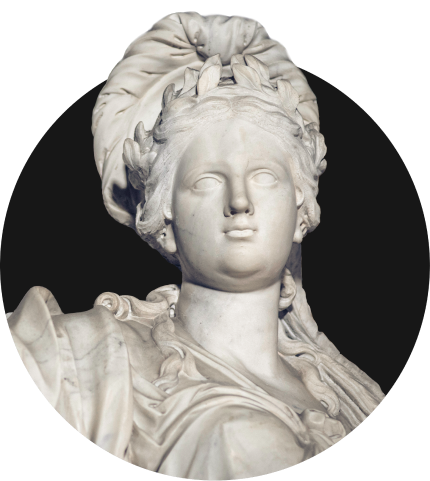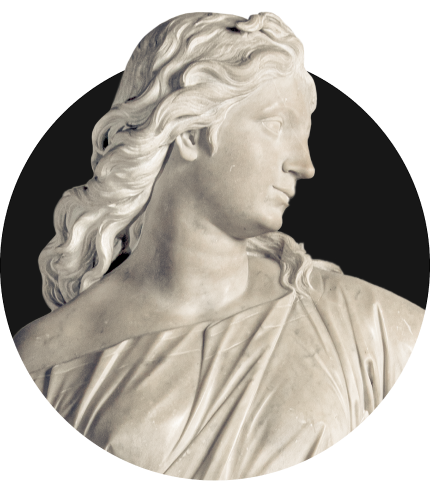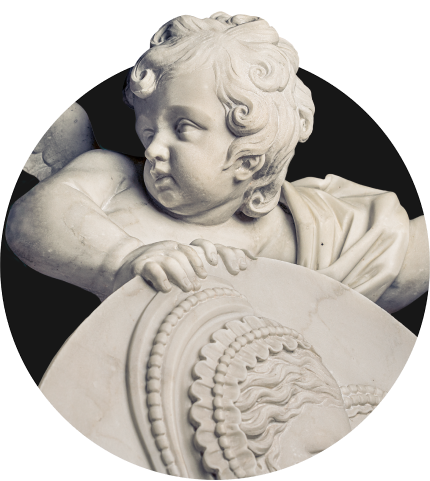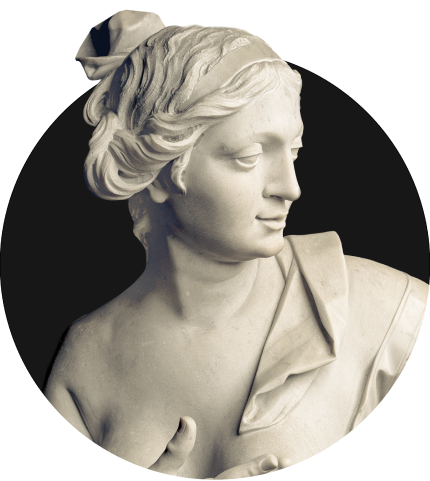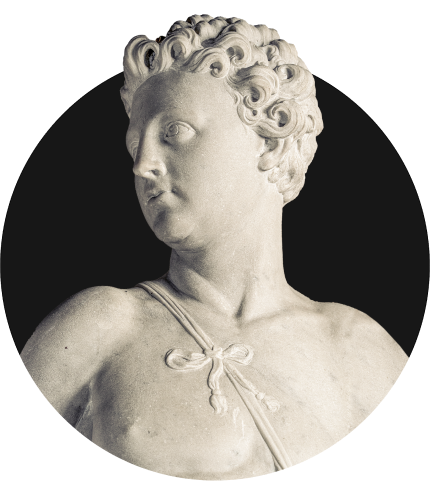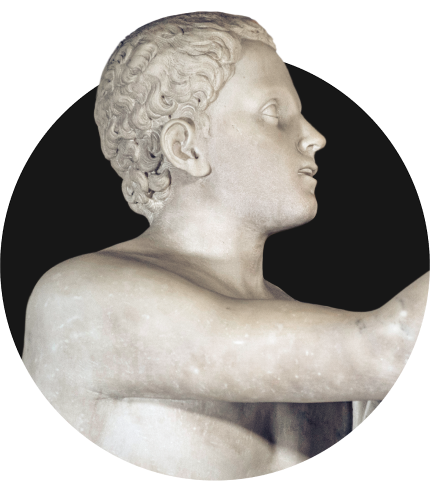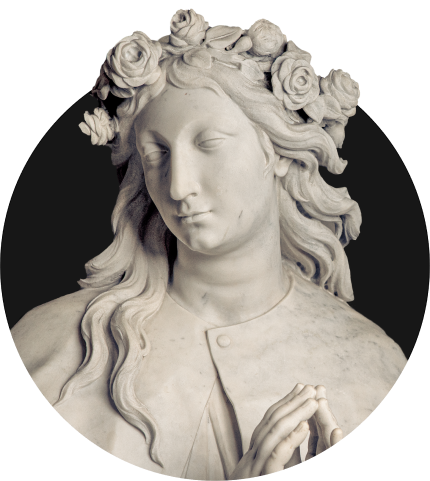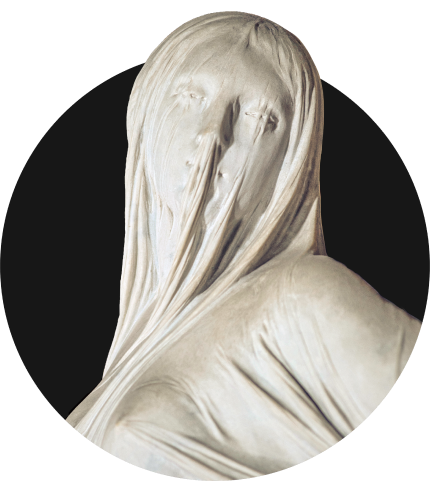
The Statues
The Princes of Sansevero
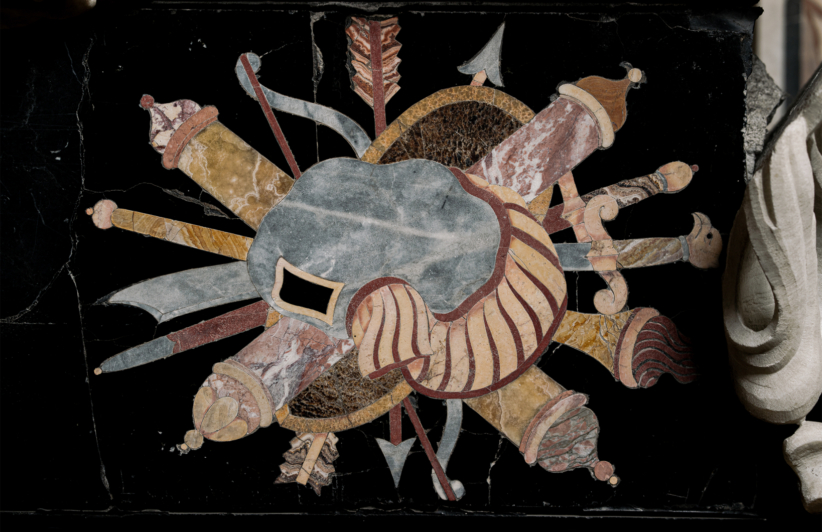
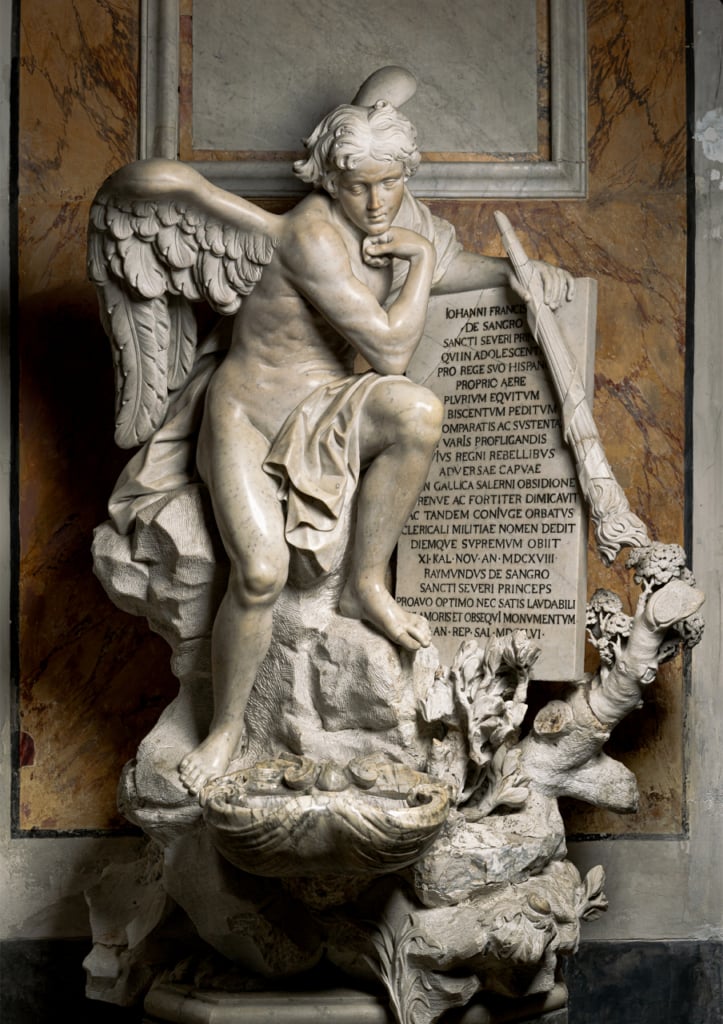
MONUMENT TO GIOVAN FRANCESCO DI SANGRO, FIFTH PRINCE OF SANSEVERO
Francesco Celebrano (?), c. 1756This monument was erected to the memory of the fifth Prince of Sansevero, who died in 1698 (and not in 1618 as the plaque would have it, due to an engraving error or a mistake by the late nineteenth-century restorer), and is symmetrical to the one on the left of the entrance. Experts tend to attribute the Monument to Giovan Francesco di Sangro to Celebrano, but some see in it the hand of Queirolo.
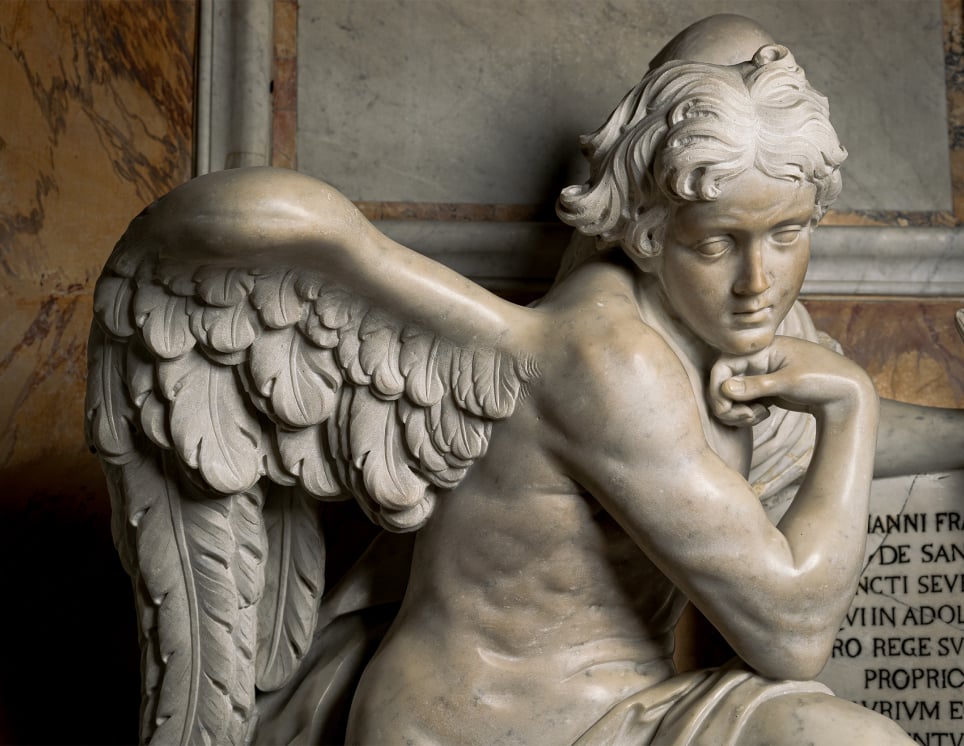
An angel with a sorrowful expression holds a lowered torch as a sign of grief. Yet again there are ornamental arboreal motifs and a holy water fountain in the form of a shell. As a whole, the monument exhibits a certain grace and compositional unity. Raimondo di Sangro’s memorial dedication dates back to 1756 and emphasises the loyalty of the deceased to the Spanish Crown, proven at Salerno against the French and in the suppression of dangerous revolts in the Kingdom of Naples. After the death of his wife, the fifth Prince of Sansevero decided to take the cloth in later life.
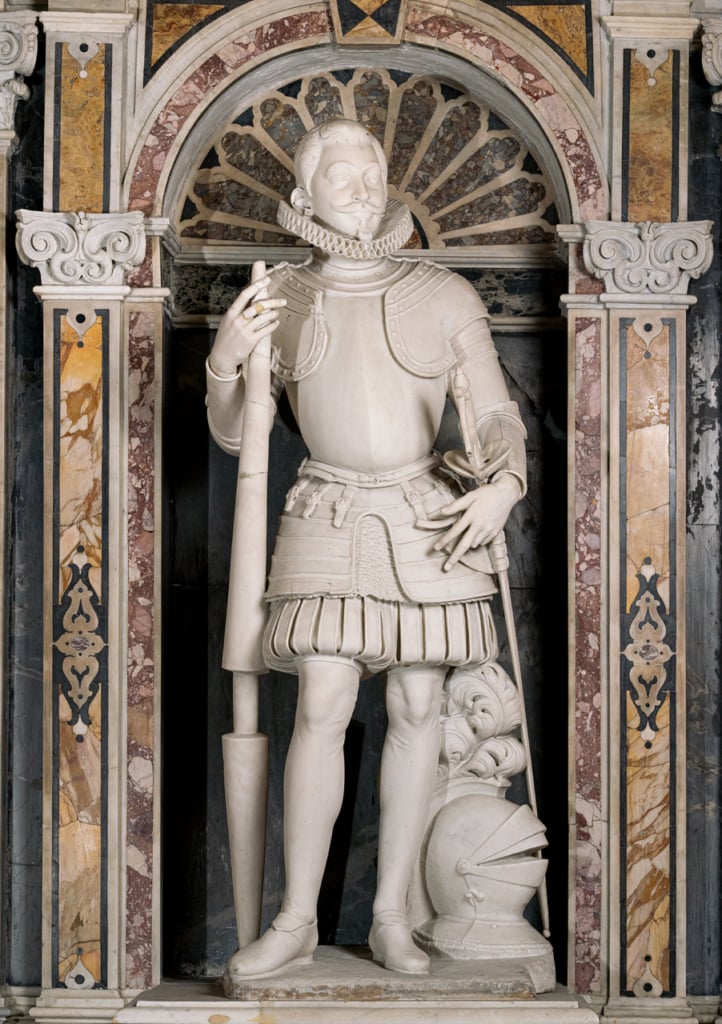
MONUMENT TO GIOVAN FRANCESCO DI SANGRO, FIRST PRINCE OF SANSEVERO
Giacomo Lazzari (?), first half of the seventeenth century.Giovan Francesco di Sangro, here portrayed in military dress, is the Duke of Torremaggiore (as well as first Prince of Sansevero) who – according to Cesare d’Engenio Caracciolo in his Sacred Naples (1623) – is said to have founded a small chapel in around 1590, the nucleus for what would become the Sansevero Chapel. The Monument to Giovan Francesco di Sangro was most probably the work of Giacomo Lazzari, even if a number of academics attribute it to Michelangelo Naccherino.
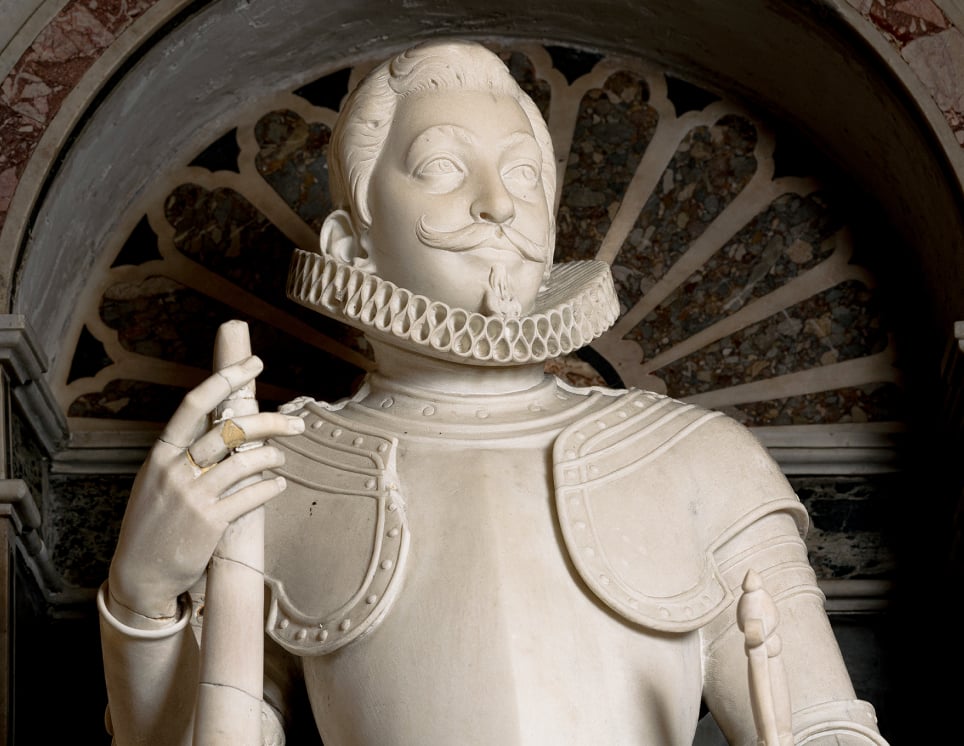
Even though it shares some stylistic features with the Monument to Paolo di Sangro, fourth Prince of Sansevero, the statue of Giovan Francesco is more sober. We note the refinement of the multi-coloured marble and the decorated pilasters coupled with the severity and poise of the figure, here shown in a dignified pose. The first Prince of Sansevero, who died in his eighties in 1604, was a brave soldier and took part in a large number of campaigns in Africa and Europe (he also fought as regimental commander in the famous battle of Lepanto in 1571). The monument and the memorial plaque were commissioned by his son, Alessandro di Sangro, Patriarch of Alexandria.

MONUMENT TO GIOVAN FRANCESCO DI SANGRO, THIRD PRINCE OF SANSEVERO
Antonio Corradini (?), 1752.The authorship of this Monument to Giovan Francesco di Sangro is even now uncertain. Marina Causa Picone attributes it to Celebrano. Rosanna Cioffi and Oderisio de Sangro agree in attributing it to Corradini, identifying the work in question with Corradini’s Sorrow, discussed by the historian Giangiuseppe Origlia in 1754. The third Prince of Sansevero died at forty during an expedition to Africa in 1627.

As well as the usual motif of the winged angel, we have the less traditional one of the shell that, as a holy water fountain, would seem so placed as to gather the tears of the weeping angel. The work has vertical movement, and the arboreal ornamentation recalls the bas-relief of the High Altar. On the plaque, Raimondo di Sangro commemorates his ancestor’s military career, cut short by an incurable disease. A curious detail: Giovan Francesco died excommunicated, so his remains were exhumed and moved twice, the first time from the parish church of Castelnuovo and the second time from the Sansevero Chapel, on the instructions of the bishop of Naples, Monsignor Boncompagni.
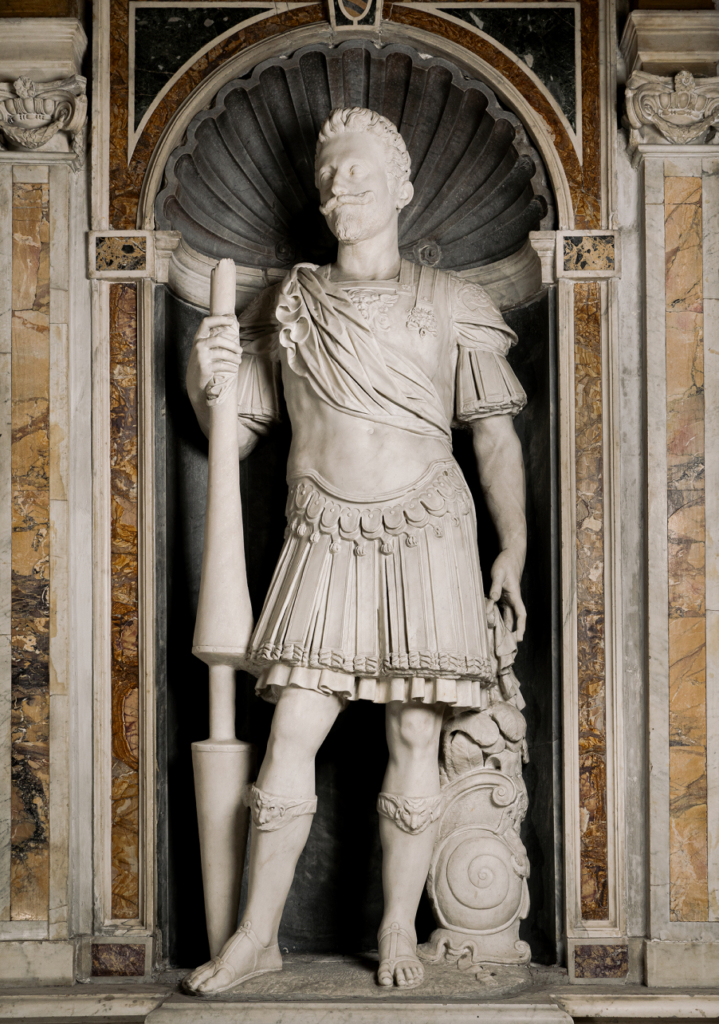
MONUMENT TO PAOLO DI SANGRO, SECOND PRINCE OF SANSEVERO
Michelangelo Naccherino, c. 1609-1615The first chapel on the right contains the mausoleum of Paolo, second Prince of Sansevero. The sculptor’s identity was long a matter of debate, but recent research attributes it to Michelangelo Naccherino, believed to have completed it between 1609 and 1615. Originally, the monument had three statues, with the Prince in the centre and allegorical figures on either side. These were later removed during extensive renovations to the Chapel, commissioned by Raimondo di Sangro in the mid-1700s.

The Prince is dressed as a Roman centurion, to recall the renown he earned during the Spanish campaign under Philip III, whose intimate advisor he was. The Prince has a solemn bearing, and is holding a broken lance. At his feet is a plumed helmet. Unlike the other seventeenth-century monuments, rich in polychromatic inlay, this one has simple decoration, a severe composition, and is static, far removed from the mobility of the baroque. The plaque recalls the strength of mind shown by Paolo on the point of death due to ill health at the age of fifty-seven.
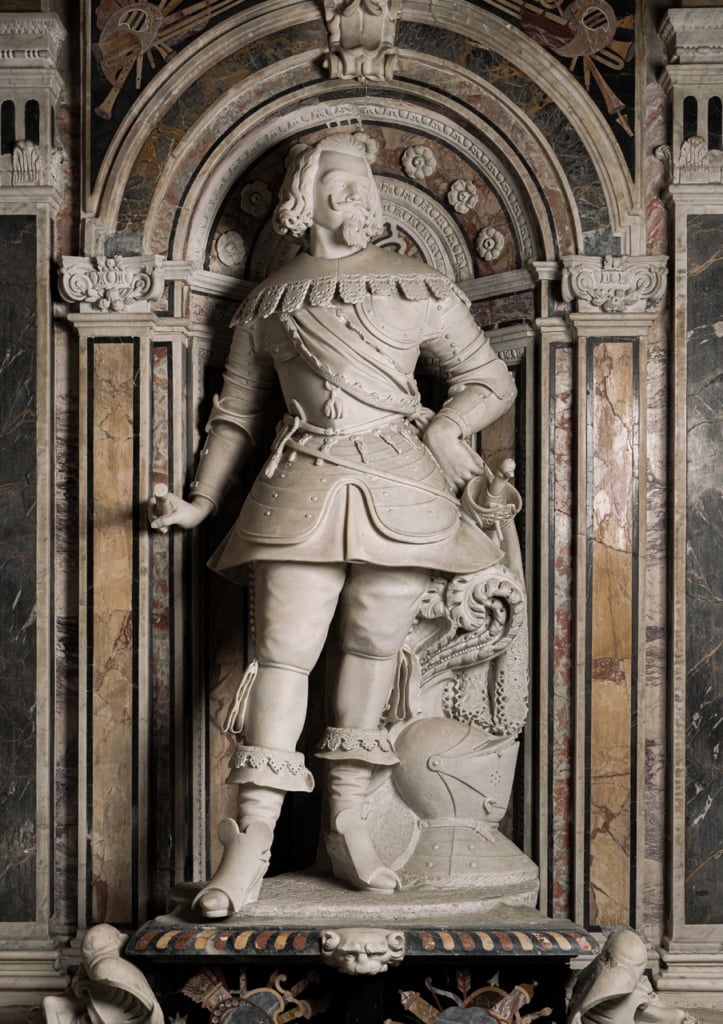
MONUMENT TO PAOLO DI SANGRO, FOURTH PRINCE OF SANSEVERO
Berardo Landini e Giulio Mencaglia, 1642.The funerary statue dedicated to the fourth Prince of Sansevero, who died in 1636, is unanimously considered the most striking of the seventeenth-century works in the Chapel. Long attributed to the Fanzago school, if not to Cosimo Fanzago himself, the Monument to Paolo di Sangro is in reality the result of cooperation between Berardo Landini and Giulio Mencaglia, as some archive sources discovered by Eduardo Nappi show, and which give weight to the previously expressed hypothesis by the critic Marina Causa Picone.

The polychrome marble, inlayed in mother of pearl, is of particular note, with its harmonious pilasters framing the agile and vigorous figure of Paolo di Sangro, avoiding any vain mannerism. Among the decorative motifs are two masks of an almost plant-like appearance, placed to the sides of the sarcophagus, and two small busts of lions placed near a skull and an hourglass, clear symbols of transience. The inscription lists the virtues and the warring feats of the deceased, as well as the other decorations which Philip IV had bestowed upon him, including knighthood with the Order of the Golden Fleece. As a demonstration of the artistic merit of the monument, one need only recall that Pompeo Sarnelli published an illustration of it – the first example of a work from the Chapel – in his Guide to Naples in 1685.

MONUMENT TO PAOLO DI SANGRO, SIXTH PRINCE OF SANSEVERO
Antonio Corradini, c. 1742In the second chapel on the right is situated the Monument to Paolo di Sangro, grandfather of Raimondo, who died in 1726 at the age of sixty-seven years. It is likely that in its place, until the eighteenth-century reorganisation of the Chapel, there stood the Monument to Alessandro di Sangro, which was then moved to the left of the High Altar. As usual, attribution to Antonio Corradini comes from Origlia, a contemporary and always reliable source. The engraved dedication bears the date of 1742, and academics consider that to be the year – or one very close to it – in which Corradini’s marble was finished, and so would therefore be the first work commissioned by Raimondo di Sangro for the Chapel.
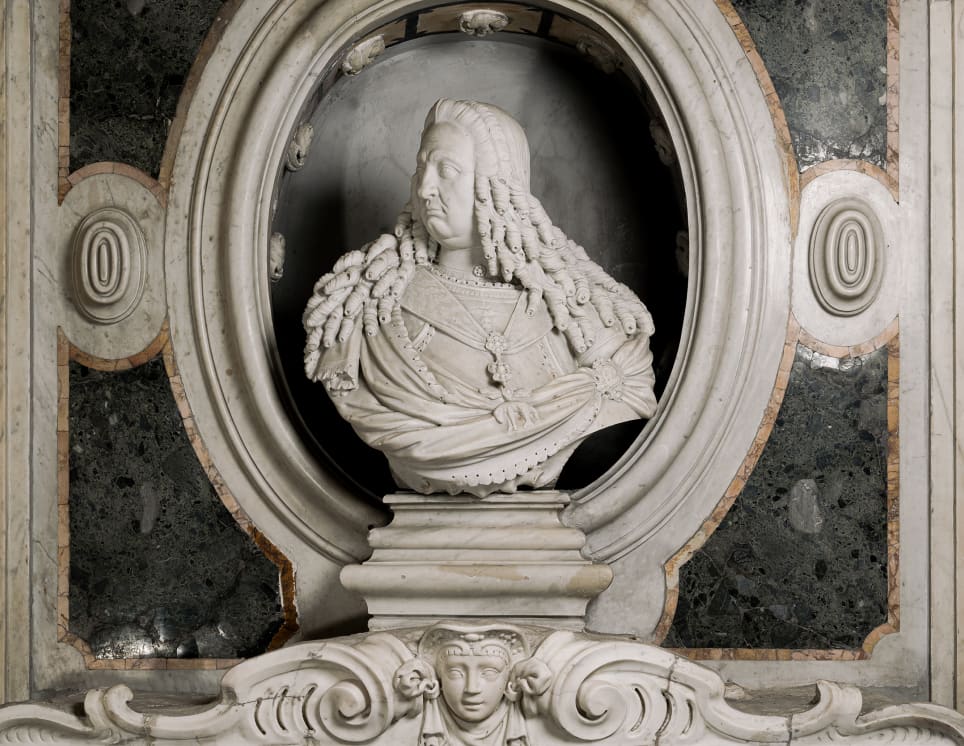
Located in a small niche and free of all symbolism, the bust is of great interest as it is a typical example of eighteenth-century portraiture, severe and evidently realistic. Paolo di Sangro belonged to the Neapolitan political élite under the Austrian Viceroys, holding the important position of prefect of the food administration and becoming counsellor a latere of the Viceroy. Emperor Charles VI decorated him with the Order of the Golden Fleece (the portrait shows him with the insignia around his neck) and made him a Grandee of Spain of the First Class. Raimondo was very close to his grandfather Paolo, who took care of him during his childhood, and upon his death left him heir to the title and the household at the age of only sixteen years.
Gallery
Map
- High altar
- The monument to Alessandro di Sangro
- Modesty
- Saint Rosalia
- The sweetness of marital yoke
- Portrait of Vincenzo di Sangro
- Religious zeal
- Monument to Giovan Francesco
di Sangro, first Prince of Sansevero - Liberality
- Monument to Paolo di Sangro,
fourth prince - Decorum
- Monument to Giovan Francesco
di Sangro, third prince - Monument to Cecco di Sangro
- Monument to Giovan Francesco
di Sangro, fifth prince - The veiled Christ
- Glory of Heaven
- Disillusion
- Saint Oderisio
- Sincerity
- The tomb of Raimondo di Sangro
- The labyrinth floor
- Self-control
- Monument to Paolo di Sangro,
sixth prince - Education
- The anatomical machines
- Madonna and child
- Portrait of Raimondo di Sangro
- Monument to Paolo di Sangro,
second prince - Divine Love

